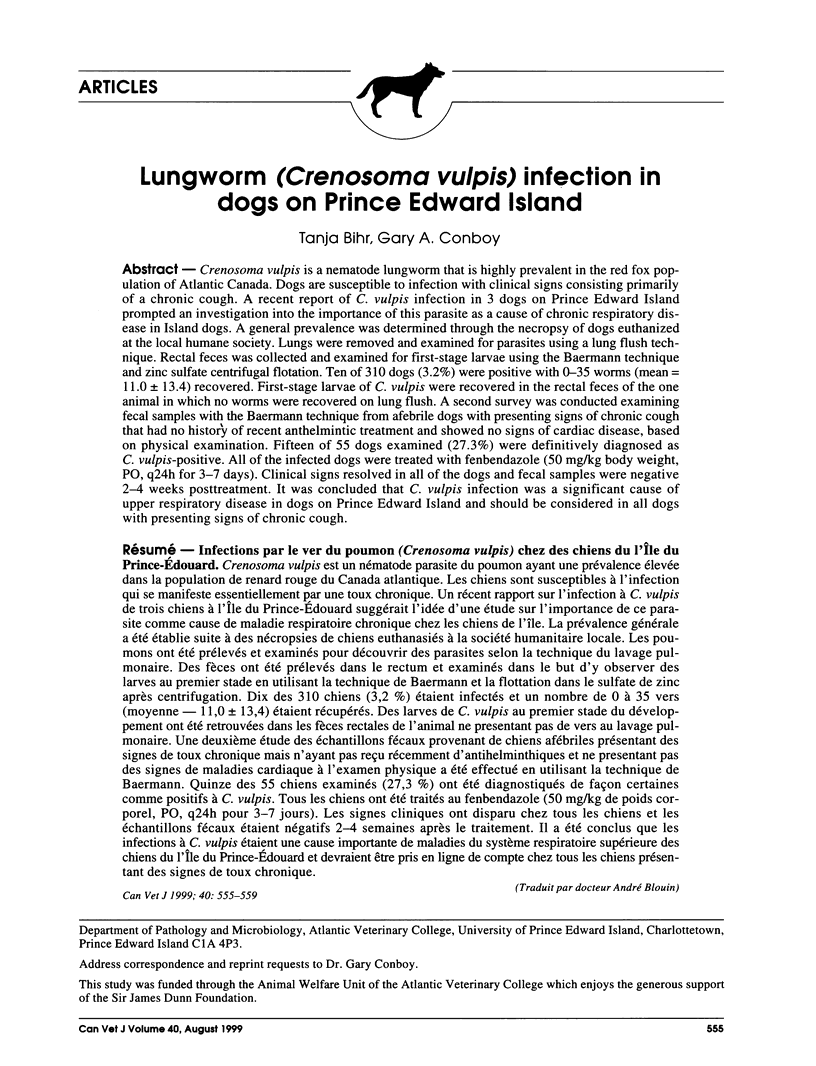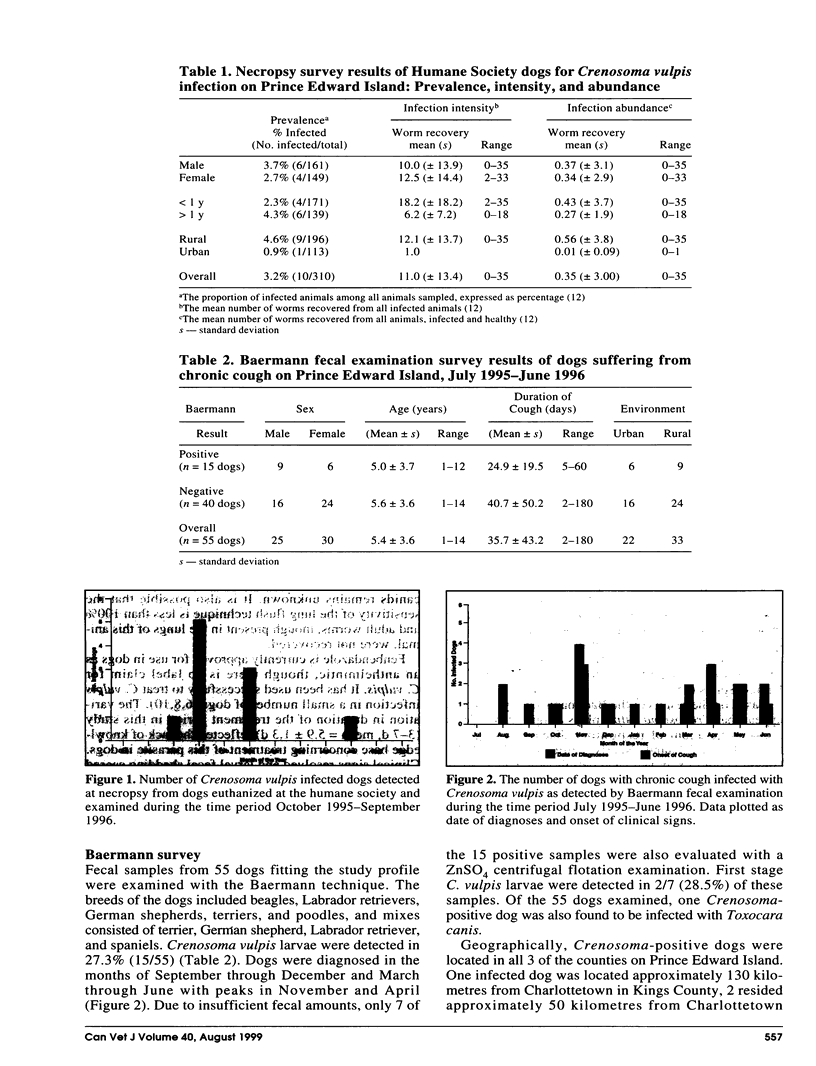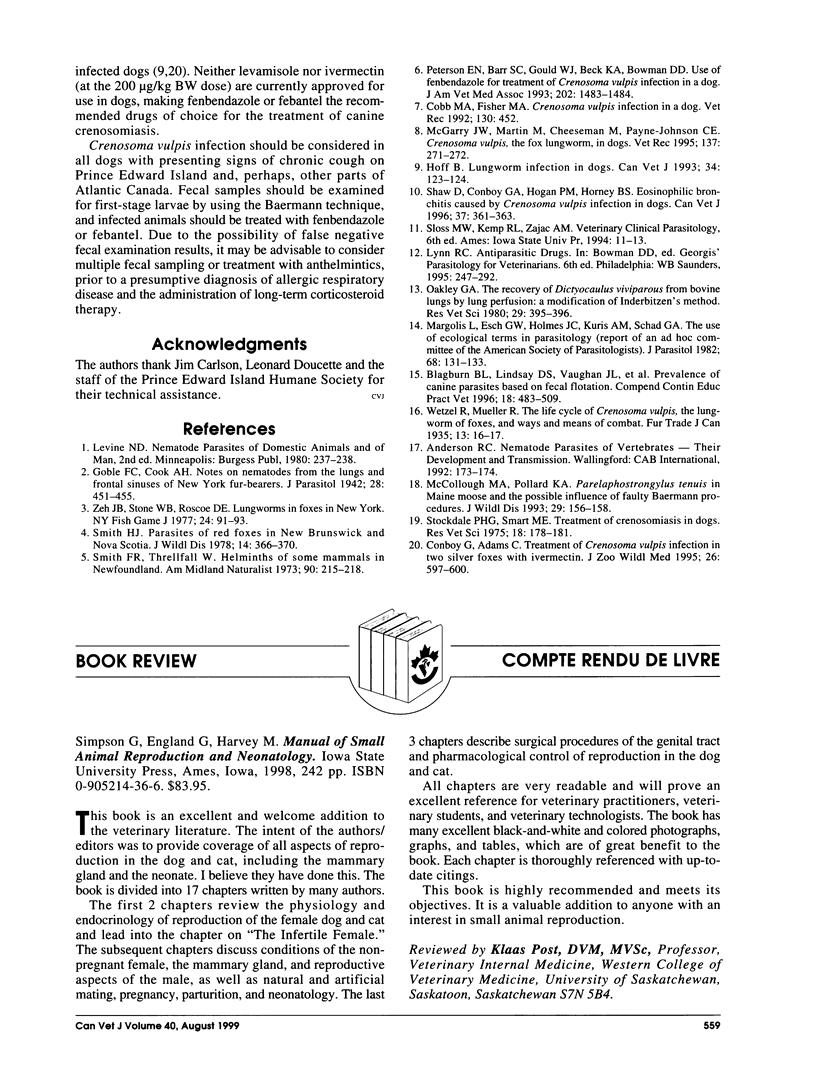Abstract
Crenosoma vulpis is a nematode lungworm that is highly prevalent in the red fox population of Atlantic Canada. Dogs are susceptible to infection with clinical signs consisting primarily of a chronic cough. A recent report of C. vulpis infection in 3 dogs on Prince Edward Island prompted an investigation into the importance of this parasite as a cause of chronic respiratory disease in Island dogs. A general prevalence was determined through the necropsy of dogs euthanized at the local humane society. Lungs were removed and examined for parasites using a lung flush technique. Rectal feces was collected and examined for first-stage larvae using the Baermann technique and zinc sulfate centrifugal flotation. Ten of 310 dogs (3.2%) were positive with 0-35 worms (mean = 11.0 +/- 13.4) recovered. First-stage larvae of C. vulpis were recovered in the rectal feces of the one animal in which no worms were recovered on lung flush. A second survey was conducted examining fecal samples with the Baermann technique from afebrile dogs with presenting signs of chronic cough that had no history of recent anthelmintic treatment and showed no signs of cardiac disease, based on physical examination. Fifteen of 55 dogs examined (27.3%) were definitively diagnosed as C. vulpis-positive. All of the infected dogs were treated with fenbendazole (50 mg/kg body weight, p.o. q24 h for 3-7 days). Clinical signs resolved in all of the dogs and fecal samples were negative 2-4 weeks posttreatment. It was concluded that C. vulpis infection was a significant cause of upper respiratory disease in dogs on Prince Edward Island and should be considered in all dogs with presenting signs of chronic cough.
Full text
PDF




Images in this article
Selected References
These references are in PubMed. This may not be the complete list of references from this article.
- Cobb M. A., Fisher M. A. Crenosoma vulpis infection in a dog. Vet Rec. 1992 May 16;130(20):452–452. doi: 10.1136/vr.130.20.452. [DOI] [PubMed] [Google Scholar]
- Hoff B. Ontario. Lungworm (Crenosoma vulpis) infection in dogs. Can Vet J. 1993 Feb;34(2):123–124. [PMC free article] [PubMed] [Google Scholar]
- McCollough M. A., Pollard K. A. Parelaphostrongylus tenuis in Maine moose and the possible influence of faulty Baermann procedures. J Wildl Dis. 1993 Jan;29(1):156–158. doi: 10.7589/0090-3558-29.1.156. [DOI] [PubMed] [Google Scholar]
- McGarry J. W., Martin M., Cheeseman M. T., Payne-Johnson C. E. Crenosoma vulpis, the fox lungworm, in dogs. Vet Rec. 1995 Sep 9;137(11):271–272. doi: 10.1136/vr.137.11.271. [DOI] [PubMed] [Google Scholar]
- Oakley G. A. The recovery of Dictyocaulus viviparus from bovine lungs by lung perfusion: a modification of Inderbitzen's method. Res Vet Sci. 1980 Nov;29(3):395–396. [PubMed] [Google Scholar]
- Peterson E. N., Barr S. C., Gould W. J., 3rd, Beck K. A., Bowman D. D. Use of fenbendazole for treatment of Crenosoma vulpis infection in a dog. J Am Vet Med Assoc. 1993 May 1;202(9):1483–1484. [PubMed] [Google Scholar]
- Shaw D. H., Conboy G. A., Hogan P. M., Horney B. S. Eosinophilic bronchitis caused by Crenosoma vulpis infection in dogs. Can Vet J. 1996 Jun;37(6):361–363. [PMC free article] [PubMed] [Google Scholar]
- Smith H. J. Parasites of red foxes in New Brunswick and Nova Scotia. J Wildl Dis. 1978 Jul;14(3):366–370. doi: 10.7589/0090-3558-14.3.366. [DOI] [PubMed] [Google Scholar]
- Stockdale P. H., Smart M. E. Treatment of crenosomiasis in dogs. Res Vet Sci. 1975 Mar;18(2):178–181. [PubMed] [Google Scholar]




